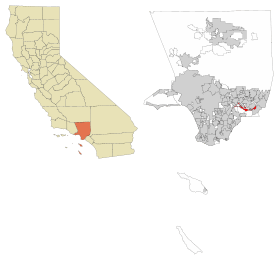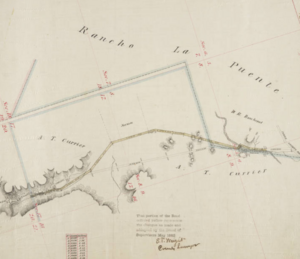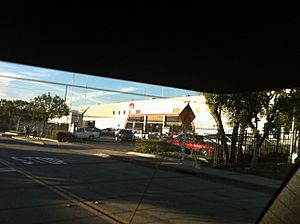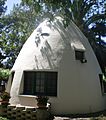City of Industry, California facts for kids
Quick facts for kids
City of Industry
|
|||
|---|---|---|---|
|
|||
| Motto(s):
Jobs, Enterprise, and Regional Infrastructure
|
|||

Location within Los Angeles County, California
|
|||
| Country | |||
| State | |||
| County | Los Angeles | ||
| Incorporated | June 18, 1957 | ||
| Named for | The city's goals to develop its industrial facilities | ||
| Government | |||
| • Type | Council-manager government | ||
| Area | |||
| • Total | 12.06 sq mi (31.24 km2) | ||
| • Land | 11.78 sq mi (30.52 km2) | ||
| • Water | 0.28 sq mi (0.72 km2) | ||
| Elevation | 322 ft (98 m) | ||
| Population
(2020)
|
|||
| • Total | 264 | ||
| • Density | 21.89/sq mi (8.451/km2) | ||
| Time zone | UTC-8 (PST) | ||
| • Summer (DST) | UTC-7 (PDT) | ||
| ZIP Codes |
90601, 91714–91716, 91732, 91744–91746, 91748, 91789
|
||
| Area codes | 562, 626, 909 | ||
| FIPS code | 06-36490 | ||
| GNIS feature IDs | 243853, 2410102 | ||
The City of Industry is a unique city in Los Angeles County, California, USA. It's located in the San Gabriel Valley. This city is special because it's mostly made up of businesses and factories. Over 3,000 companies are here, giving jobs to about 67,000 people! But here's the surprising part: only 264 people actually live in the city, according to the 2020 census. This makes it one of the least populated cities in California. The City of Industry became an official city on June 18, 1957. It has grown into a very important business center for the San Gabriel Valley.
Contents
Where is the City of Industry Located?
The City of Industry is about 17.6 miles (28.4 km) east of Los Angeles. It covers an area of about 12.07 square miles (31.24 square kilometers). Most of this area is land, with a small part being water.
| Climate data for City of Industry, California | |||||||||||||
|---|---|---|---|---|---|---|---|---|---|---|---|---|---|
| Month | Jan | Feb | Mar | Apr | May | Jun | Jul | Aug | Sep | Oct | Nov | Dec | Year |
| Mean daily maximum °F (°C) | 69 (21) |
70 (21) |
71 (22) |
76 (24) |
77 (25) |
83 (28) |
87 (31) |
88 (31) |
87 (31) |
82 (28) |
75 (24) |
70 (21) |
78 (26) |
| Mean daily minimum °F (°C) | 44 (7) |
46 (8) |
48 (9) |
51 (11) |
55 (13) |
59 (15) |
63 (17) |
63 (17) |
62 (17) |
56 (13) |
48 (9) |
44 (7) |
53 (12) |
| Average precipitation inches (mm) | 3.94 (100) |
4.42 (112) |
3.63 (92) |
0.93 (24) |
0.37 (9.4) |
0.14 (3.6) |
0.03 (0.76) |
0.10 (2.5) |
0.41 (10) |
0.53 (13) |
1.25 (32) |
2.07 (53) |
17.82 (453) |
History of the City of Industry
Early Beginnings

The land where the City of Industry now stands was once part of a huge ranch called Rancho La Puente. In 1841, William and Nicolasa Workman received this land. They were cattle ranchers and made a lot of money during the California Gold Rush.
Later, in 1917, their grandson Walter P. Temple and his wife Laura bought back some of this land. This property is now a museum called the Workman and Temple Family Homestead Museum. You can visit it for free!
Growth and Development
In the late 1800s and early 1900s, major railroads like the Southern Pacific and Union Pacific Railroad were built through this area. A main road, Valley Boulevard, also came through. These transportation links helped the area grow, especially with warehouses.
The City of Industry officially became a city on June 18, 1957. Its name comes from its main goal: to be a perfect place for factories, distribution centers, and other industrial businesses.
Key Milestones
- 1962: The City of Industry Chamber of Commerce was formed.
- 1974: The Workman House became a historical landmark.
- 1979-1980: A former landfill was turned into the Industry Hills Golf Club, which includes a hotel and golf course.
- 1981: The Industry Hills Expo Center opened. It's a large place for community events.
- 1985: The first Charity Pro Rodeo was held to raise money for young people. It still happens every year!
- 1991: The Youth Activities League started. It offers sports to kids to help them avoid gang activity.
- 1993: The City of Industry Metrolink Station opened. This helps people travel by train.
- 2204: Plans were completed to improve the busy 57/60 freeway interchange. This helps reduce traffic jams.
Emergency Services
The Los Angeles County Sheriff's Department has a station in the City of Industry. This helps keep the city safe.
Economy of the City of Industry
The City of Industry is almost entirely dedicated to business. About 92% of the city is for industrial use, and 8% is for commercial businesses like shops. There are very few homes here. The city makes most of its money from sales tax from shopping centers and property tax from businesses.
The City of Industry is a popular place for businesses from China. Many companies here deal with importing and exporting computer parts. Because of this, many Chinese business owners and workers live in nearby cities like Rowland Heights and Hacienda Heights.
Companies in the City of Industry
Many well-known companies have their main offices or a big presence here.
Some companies with headquarters in the City of Industry include:
- Alta Dena
- AMI ClubWear
- Antec
- Arconic
- CyberPowerPC
- Dacor (kitchen appliances)
- Hot Topic
- Jada Toys
- Newegg.com
- NZXT
- Sophos Ltd.
- Utility Trailer Manufacturing Company
- Yum-Yum Donuts
Other companies with a major presence here are:
- Biostar
- CoolerMaster
- DIRECTV
- FedEx
- Golden State Foods
- Goya Foods' California division
- Kellwood Company
- Lee Kum Kee USA Los Angeles Office
- Micro-Star International (MSI)
Population in the City of Industry
| Historical population | |||
|---|---|---|---|
| Census | Pop. | %± | |
| 1960 | 778 | — | |
| 1970 | 712 | −8.5% | |
| 1980 | 412 | −42.1% | |
| 1990 | 631 | 53.2% | |
| 2000 | 777 | 23.1% | |
| 2010 | 219 | −71.8% | |
| 2020 | 264 | 20.5% | |
| U.S. Decennial Census | |||
In 2010, the City of Industry had 219 people living there. Most people lived in households. The population included people of different backgrounds, with a mix of White, Black, and Asian residents. About half of the population was Hispanic or Latino.
The median age in 2010 was 37.5 years old. This means half the people were younger and half were older than that age. The city had a median household income of $49,329.
Education in the City of Industry
Several school districts serve the City of Industry:
- Whittier City Elementary School District and Whittier Union High School District
- Hacienda La Puente Unified School District (where Workman High School is located)
- Bassett Unified School District
- Rowland Unified School District
- Walnut Valley Unified School District
- Pomona Unified School District
There are also nearby colleges like Mt. San Antonio College and Rio Hondo College.
Landmarks to Visit
The Workman and Temple Family Homestead Museum is a special place to visit. It's a historic house and garden museum. You can learn about the history of Southern California in the 1800s and early 1900s. It also tells the story of the Workman-Temple family, who were very important in the region. This property is listed on the National Register of Historic Places.
-
The William Workman Home at the Workman and Temple Family Homestead Museum
City of Industry in Movies
The City of Industry is a popular spot for filming movies and commercials!
- The Puente Hills Mall was used as the Twin Pines/Lone Pine Mall in the Back to the Future movies.
- A SpeedZone entertainment center was featured in the movie Clerks II.
- A former IKEA store was used for a fight scene in Mr. & Mrs. Smith.
- Another movie, Fun with Dick and Jane, filmed a fictional store called KostMart here.
- There's even a fake McDonald's restaurant used only for filming!
- The Vineland Drive-In, one of the few operating drive-in theaters in the area, is also in the city.
- The city-owned Industry Hills Expo Center is also used for filming.
See also
 In Spanish: Industry (California) para niños
In Spanish: Industry (California) para niños












